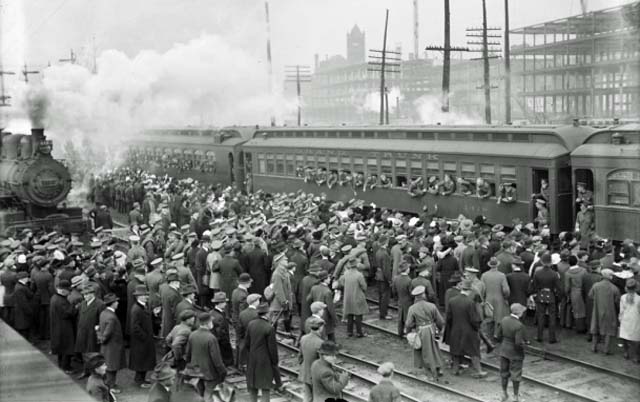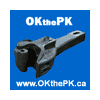|
First World War Canadian troops board trains in Toronto bound for Halifax - Date unknown Anonymous Photographer - City of
Toronto Fonds 1244 Item 821.
7 November 2014
Canadian Pacific Railway
Played Big Role in World Wars
Canada - During the First and Second World Wars virtually every soldier was transported to a training location and to the point of
departure for Europe by train, Canadian Pacific Railway (CPR).
The ships that carried troops across the ocean were often also owned by CPR.
From 1939 to 1945 CPR moved 307 million tons of freight, transported 86 million passengers including 150,000 soldiers of which nearly 130,000 were army and air
force repatriates, and thousands of sailors, according to information from CPR.
"There is an old military saying that amateurs talk tactics, experts talk logistics. It would be difficult to underestimate the logistical support to the
Canadian war effort of Canada's railroads, especially the CPR," said Bruce Shepard, museum curator for the Esplanade.
"In addition, hundreds of CPR employees, including Medicine Hat's Victoria Cross winner Pete Robertson, served with distinction."
To accomplish this, with so many of its staff enlisted in the wars, CPR suspended mandatory retirement, brought back pensioners, and trained new
workers.
In the First World War CPR provided 6,000 additional jobs.
As the strongest railway in Canada at the time it formed the Canadian Overseas Railway Reconstruction Corps.
This group of skilled engineers went overseas during and after the First World War to rebuild the railway infrastructure that had been destroyed.
CPR converted dining cars to "commissary cars" and served meals to troops at their seats instead, serving more than 11 million meals to service
personnel.
Old equipment was renovated and became hospital cars for the wounded or jail cars for prisoners of war.
It introduced new train scheduling and automatic block signaling on about 600 miles of track to handle additional volume.
At CPR's Ogden shops in Calgary 3,000 naval guns and 1,650 naval gun mounts were manufactured for the Allies during the Second World War.
By D-Day, June 1944, CPR shops had manufactured 1,420 Valentine tanks, 75 main engines for corvettes, frigates, and landing craft, more than 600 naval vessel
power equipment components, 3,000 naval guns, 1,650 naval gun mounts, 2,000 anti-submarine devices, and 120 range-finding and fire-control equipment
units.
During the First World War 52 of CPR's ships went into service for the war carrying more than a million troops and four millions tons of cargo.
Only 27 survived and were returned to the CPR.
Nine ships were torpedoed by German U-boats, two were mined, and one was captured and sunk.
In the Second World War there were 22 CPR ships requisitioned.
Six survived and five were returned to CPR.
From enemy action 12 ships had been lost, according to details from CPR.
"On our readiness to meet the challenge, and, each of us, to do our duty, there hangs the fate of a nation, the destiny of future generations," said
Sr. Edward Beatty, CPR chairman and president in January 1942.
More than 37 million telegrams were processed and delivered by CPR.
Many of those contained the heart breaking news that a loved one serving overseas had died.
Every Remembrance Day CPR stops its trains across the North American network, at 11:00, for two minutes of silence to pay tribute to all who served and
remember those who paid the ultimate sacrifice.
Gillian Slade.
|


